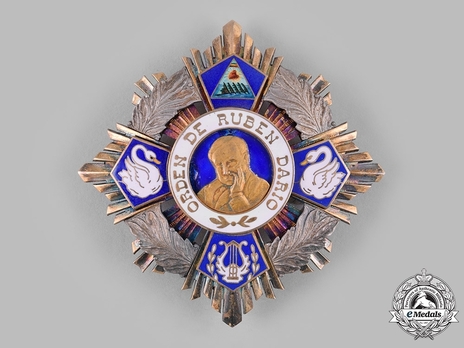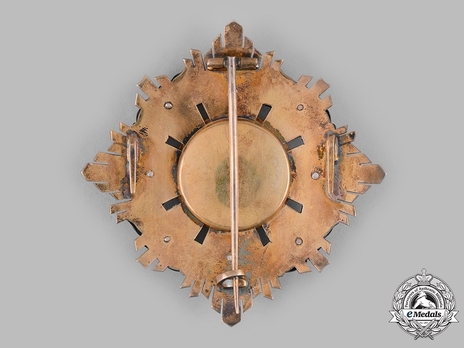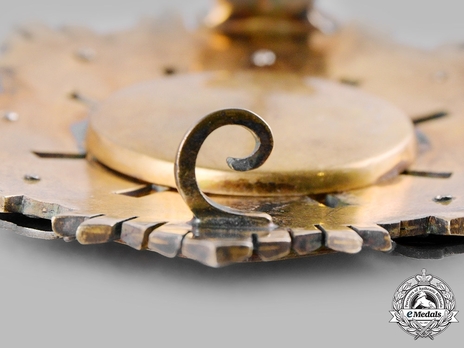Order of Ruben Darío, Grand Cross Breast Star
CATEGORY: Version
SKU: 01.NIC.0102.103.01.000
Estimated market value:



Estimated market value:
Nicaragua, Republic. An Order of Ruben Dario, Grand Cross c.1960
(Orden de Ruben Dario). Instituted in 1951. Likely Cejalvo manufacture, a sash badge consisting of an enameled blue four-armed cross in silver gilt, each arm embellished by white swans and lyres alternatively, the quadrants depicting clusters of multiple rays also in silver gilt, the obverse featuring a superposed gilt portrait of Ruben Dario, on an enameled blue background, with surrounded silver laurel wreath, suspended by a medallion with an enameled Nicaraguan coat of arms with the inscription REPUBLICA DE NICARAGUA AMERICA CENTRAL, plain reverse, measuring 43.44 mm (w) x 73.58 mm (h - inclusive the suspension), with minor tarnished silver, suspended by a full-length original sash ribbon and bow, very good condition; accompanied by a multirayed star in silver gilt, embellishing by a superposed centre-piece in blue enamels, featuring two enameled white swans on the horizontal arms, a lyric on the bottom arm and the Nicaraguan coat of arms on the top arm, surrounded by a silver laurel wreath, the obverse featuring a superposed portrait of Ruben Dario in silver gilt, on an enameled blue background, plain reverse with vertical pinback flanked by dual prongs, measuring 77.59 mm (w) x 77.76 mm (h), with minor tarnished silver, very good.
The Order of Ruben Darío was established by Anastasio Somoza García on February 15, 1951. It is still conferred upon Nicaraguans and foreigners in recognition of meritorious service to Nicaragua and society in the fields of literature, art, science, and international relations.
The Order's grades are Collar, Grand Cross, Grand Officer, Commander, Officer, and Knight. The current statutes were approved in 2002.
The Order was named after the famous Nicaraguan writer and poet, Ruben Darío García Sarmiento (1867-1916), who initiated the "Modernismo" in Latin America fostering the relations between Latin American and European Hispanic writers.

Comments
Sign in to comment and reply.


Scroll Top